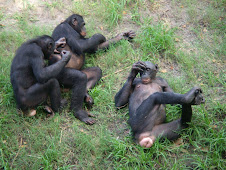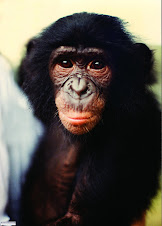
 I always like the top photo, because it looks like I am doing some kind of barefoot water ballet. Instead, Moseli, a nurse, and I were mist-netting for bats. I was a volunteer in the Peace Corps, on loan to the World Health Organization (WHO). We were trying to determine the wild animal reservoir for the virus that caused monkeypox in Zaire (now the Democratic Republic of the Congo).
I always like the top photo, because it looks like I am doing some kind of barefoot water ballet. Instead, Moseli, a nurse, and I were mist-netting for bats. I was a volunteer in the Peace Corps, on loan to the World Health Organization (WHO). We were trying to determine the wild animal reservoir for the virus that caused monkeypox in Zaire (now the Democratic Republic of the Congo).The mist net was so fine, that it was nearly invisible to the eye, and was typically strung across streams, which were used by many species of bats as highways (as opposed to dense forests, where there were many impediments to flights). A mist net could be bunched up into the size of a fist, and it was easily torn by the captured bats, which we extricated with care.
The bottom photo is Moseli holding a male hammer-headed bat, the largest bat in Africa. The males, weighing up to one pound, are twice the size of the females. They are sexually dimorphic, with males having large square heads, and a huge larynx that extends into the thorax, displacing the lungs and heart. The voice box is used to produce the loud calls to attract females.
Hammer-headed bats meet at "leks," or mating arenas, for copulation. The males gather first, in small groups, where they spread out and establish their territory. They call loudly, with honking, croaking squawks. The females follow the sounds that can be heard from a great distance and come to the lek to select their mate.
Lekking (from Swedish "to play") is a promiscuous mating system that is either classical, where visual cues are used, like the tail display of peafowl or exploded, where the attractant is vocal, such as that of the hammer-headed bat.













No comments:
Post a Comment